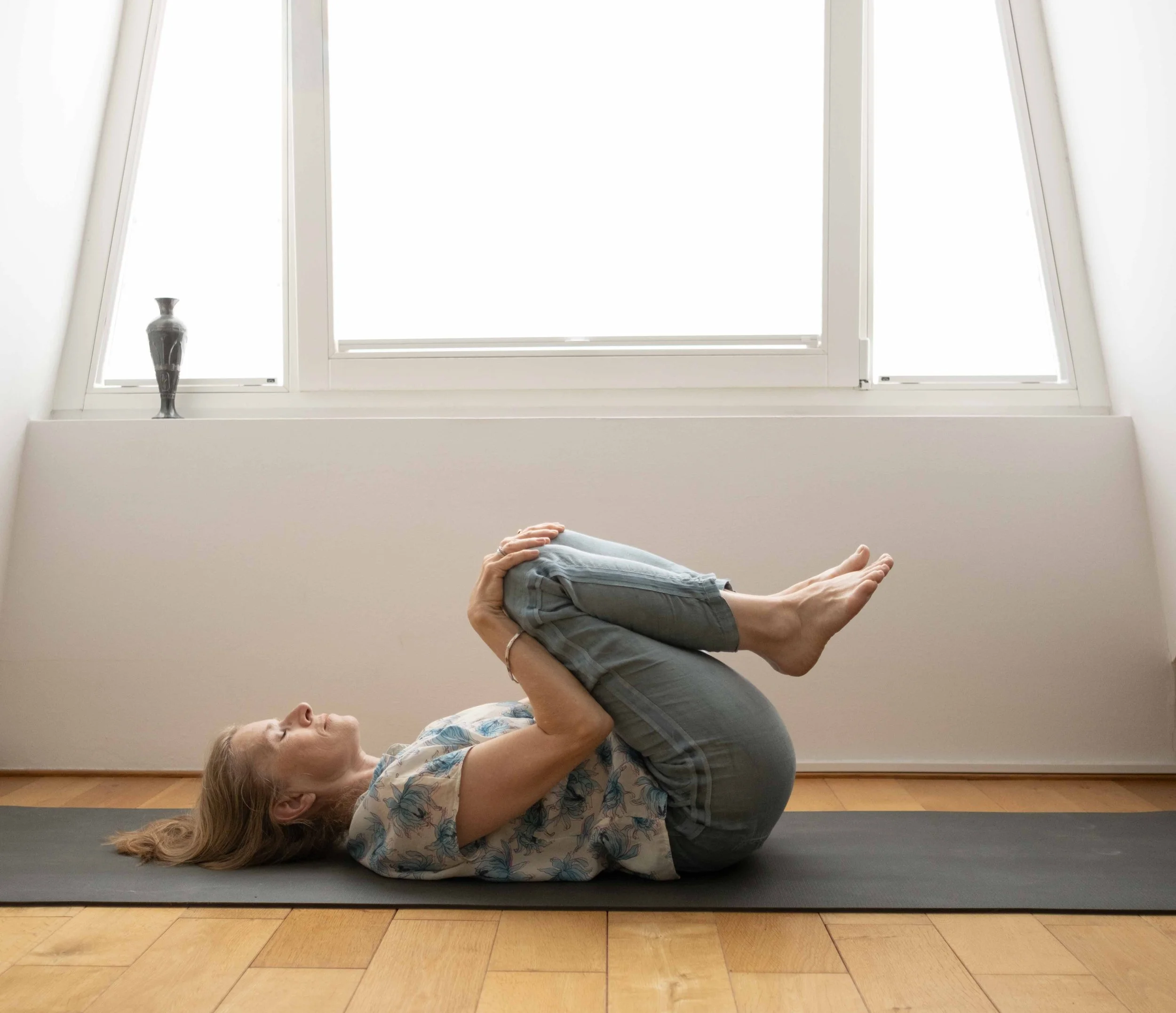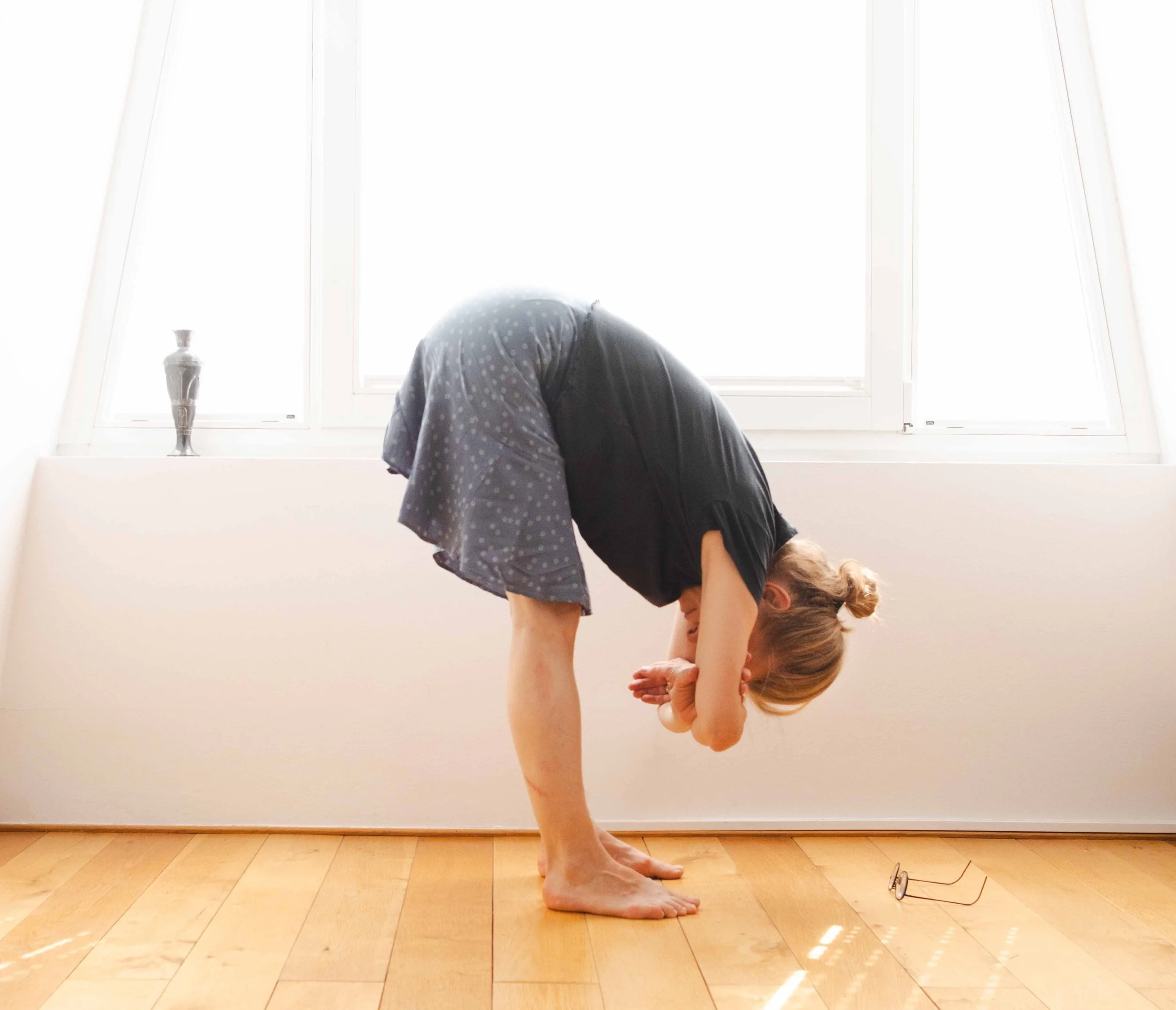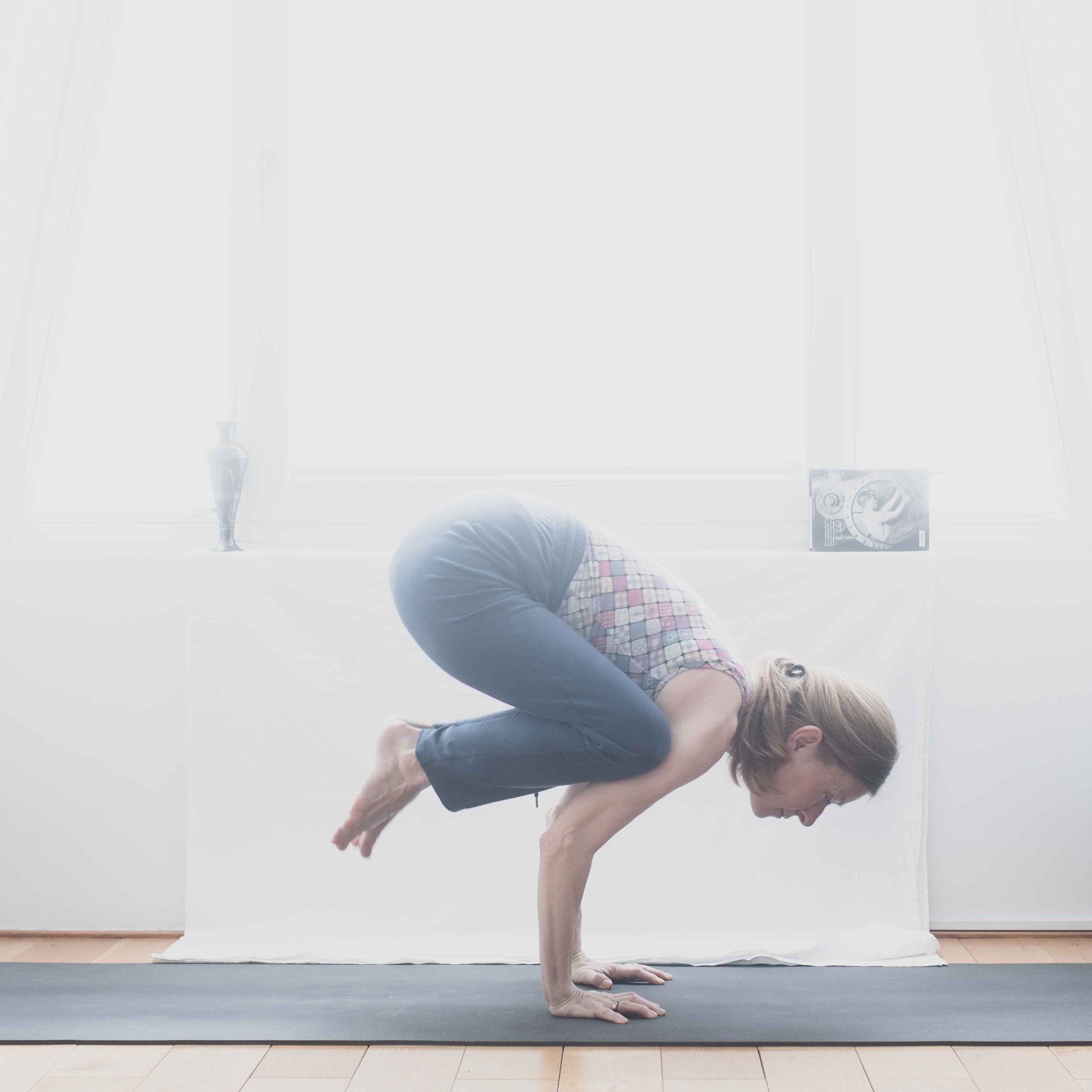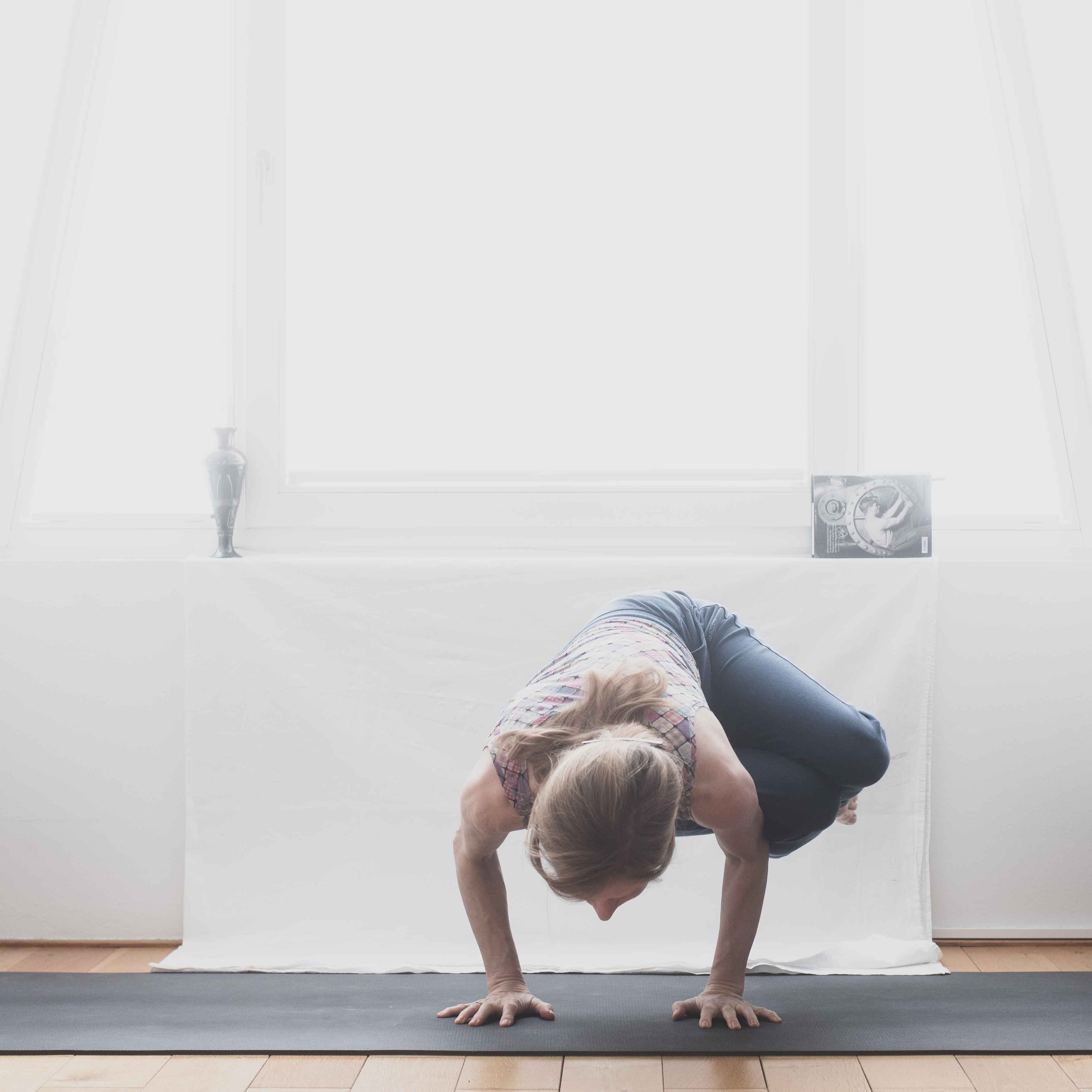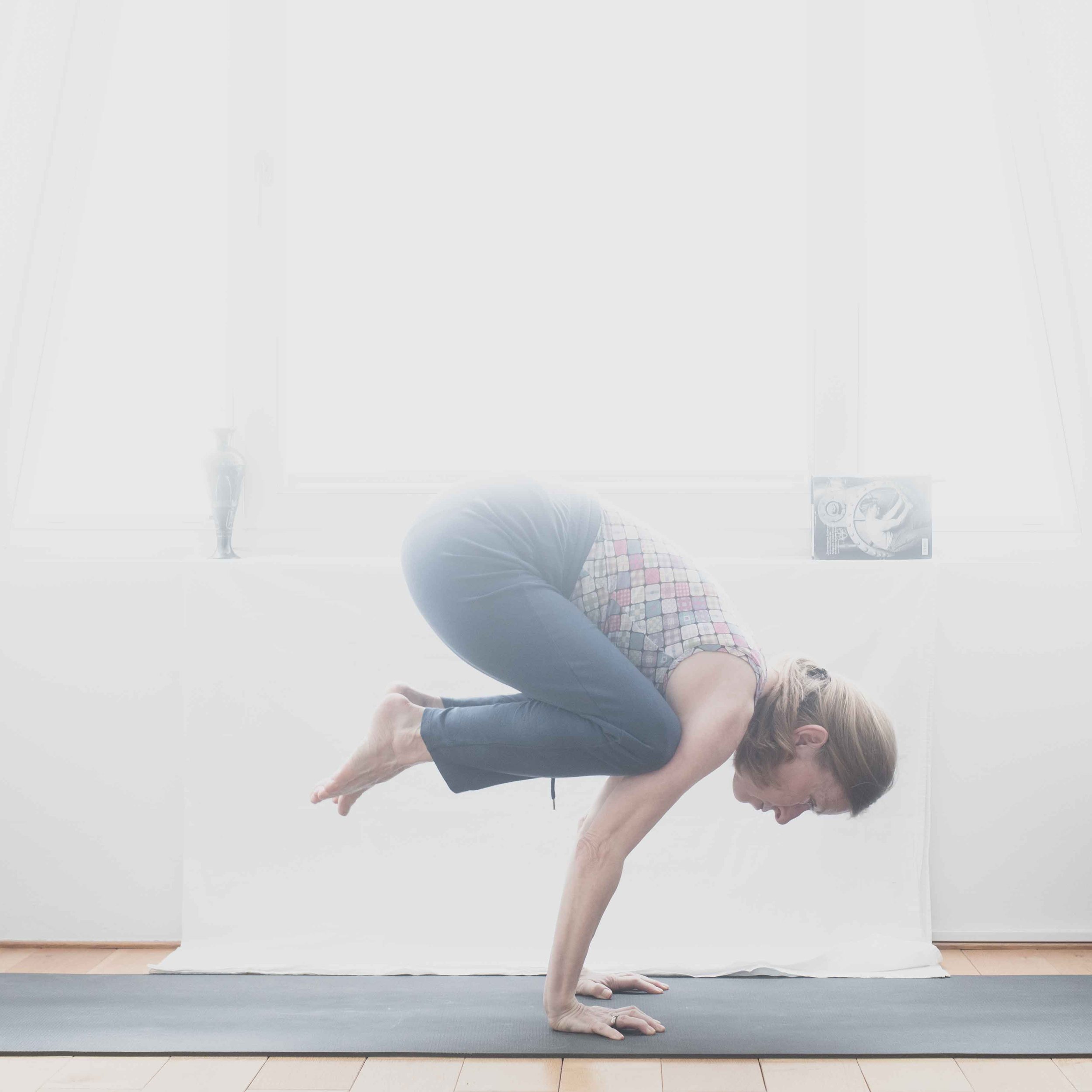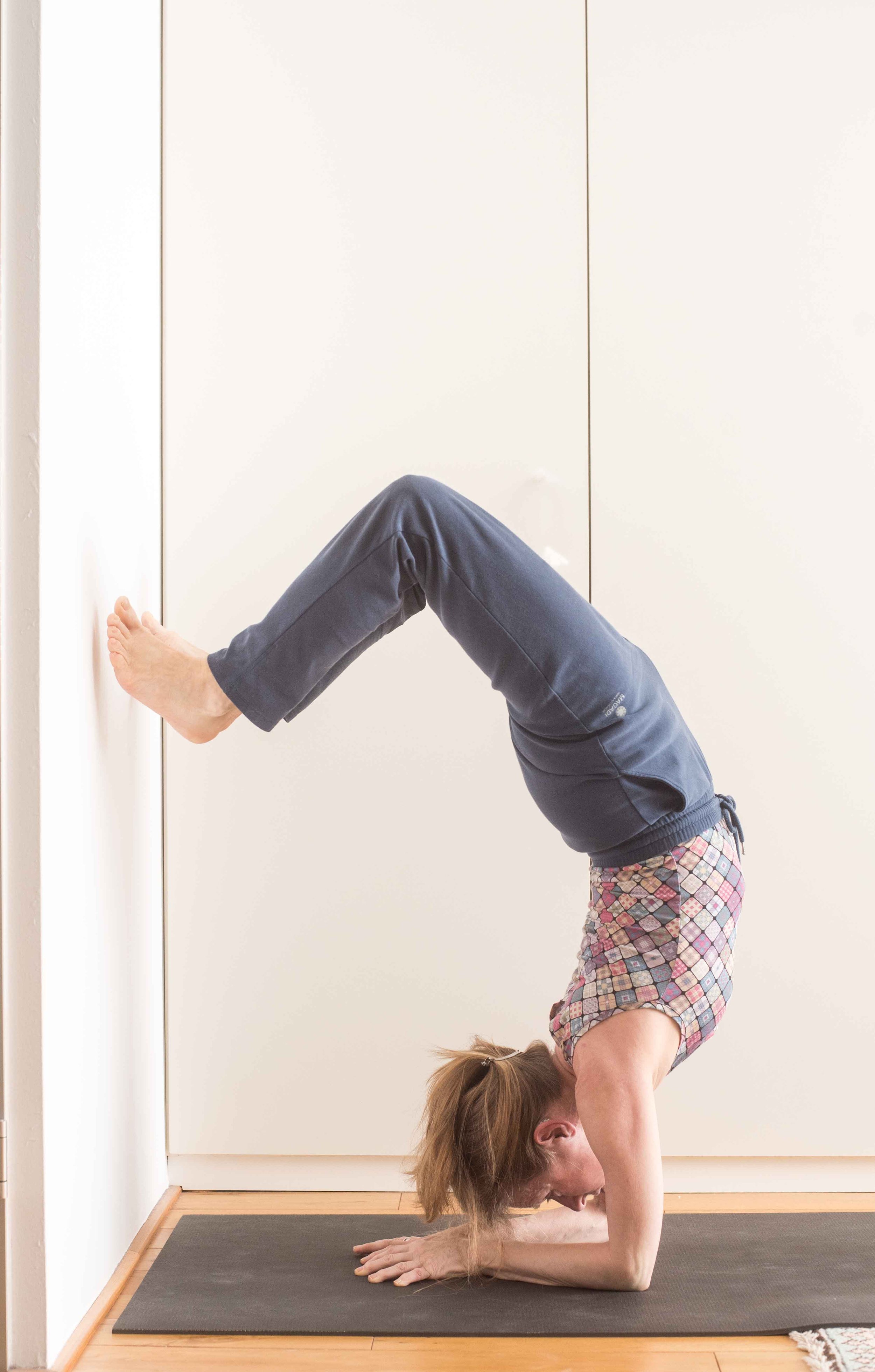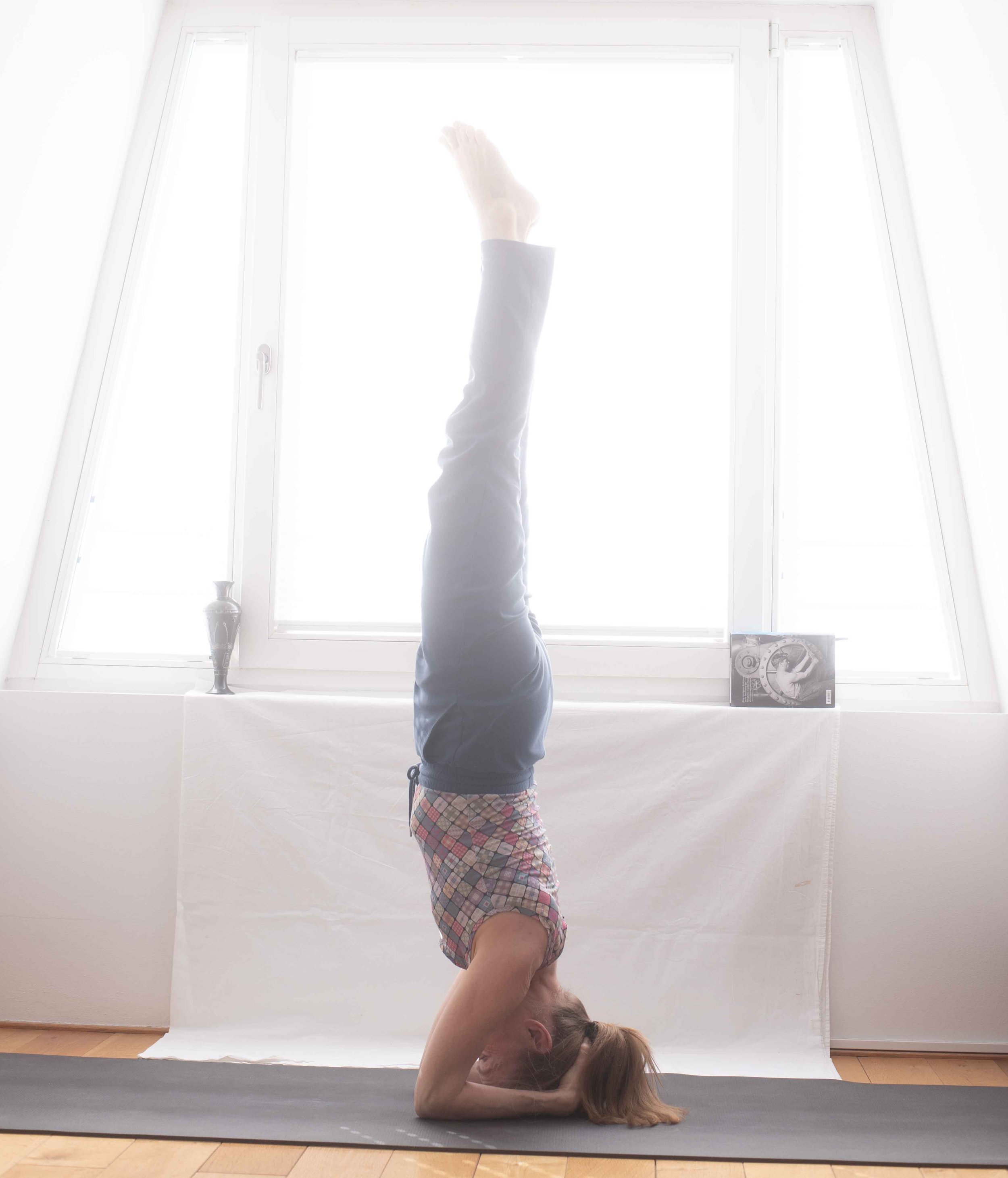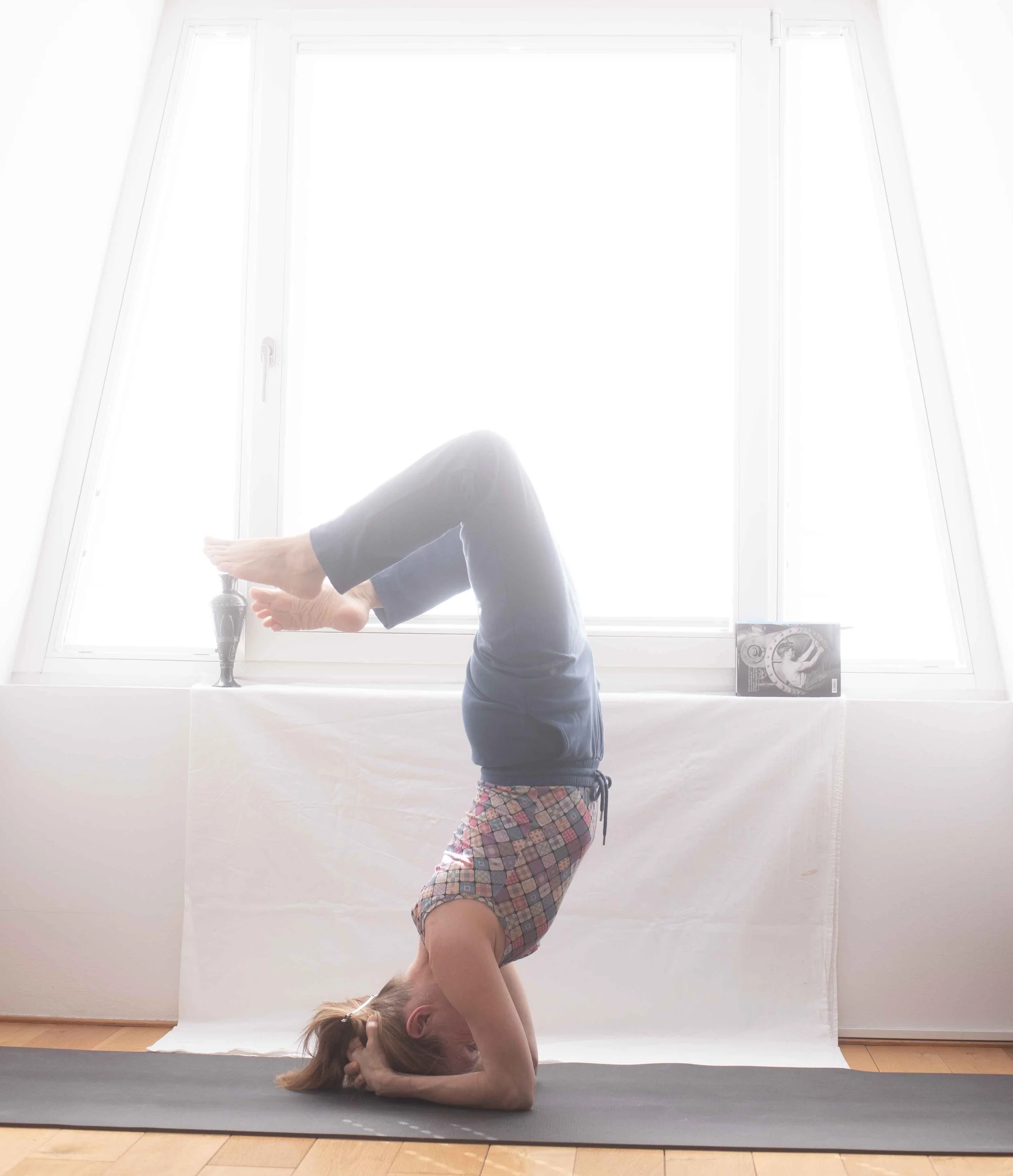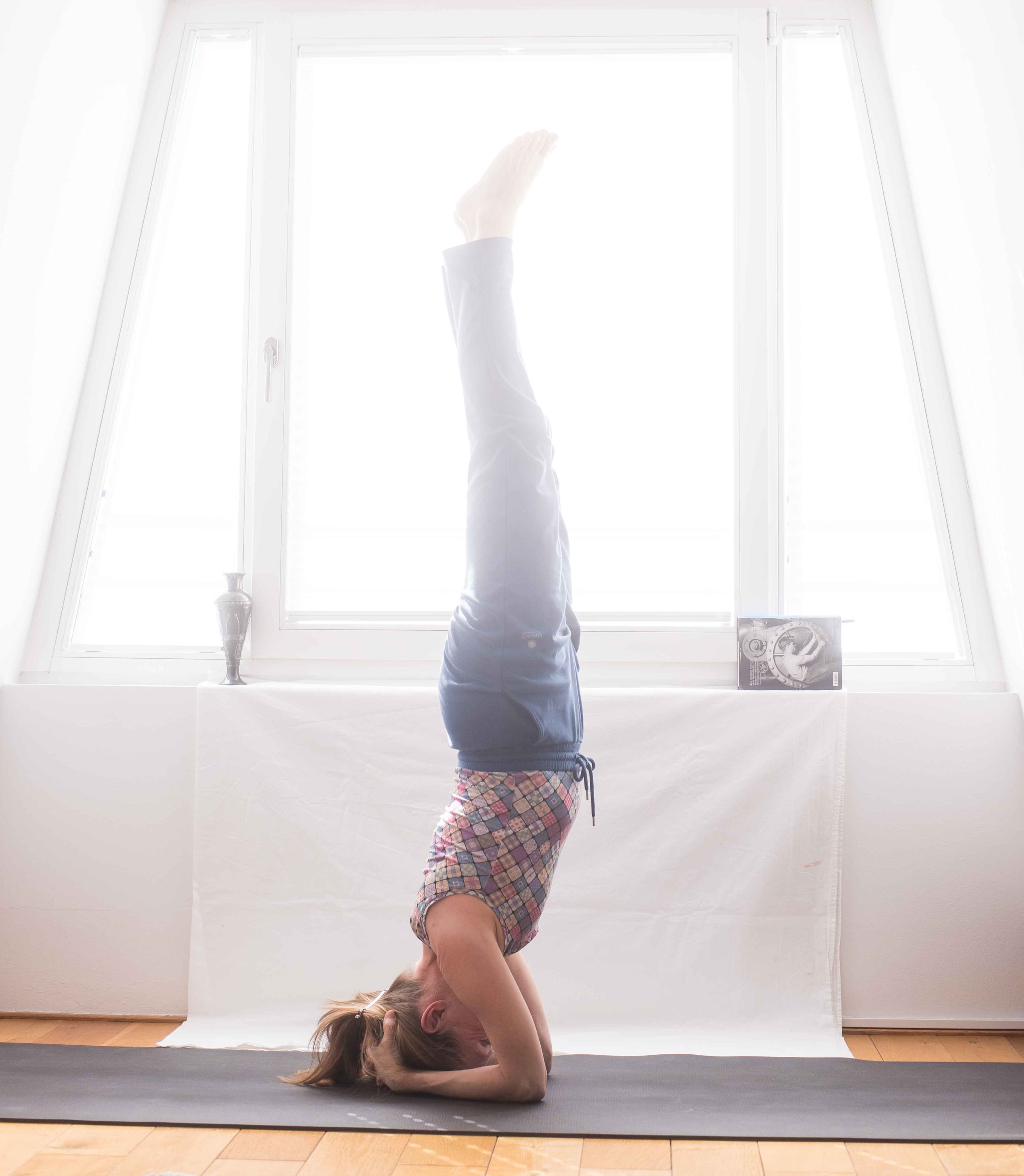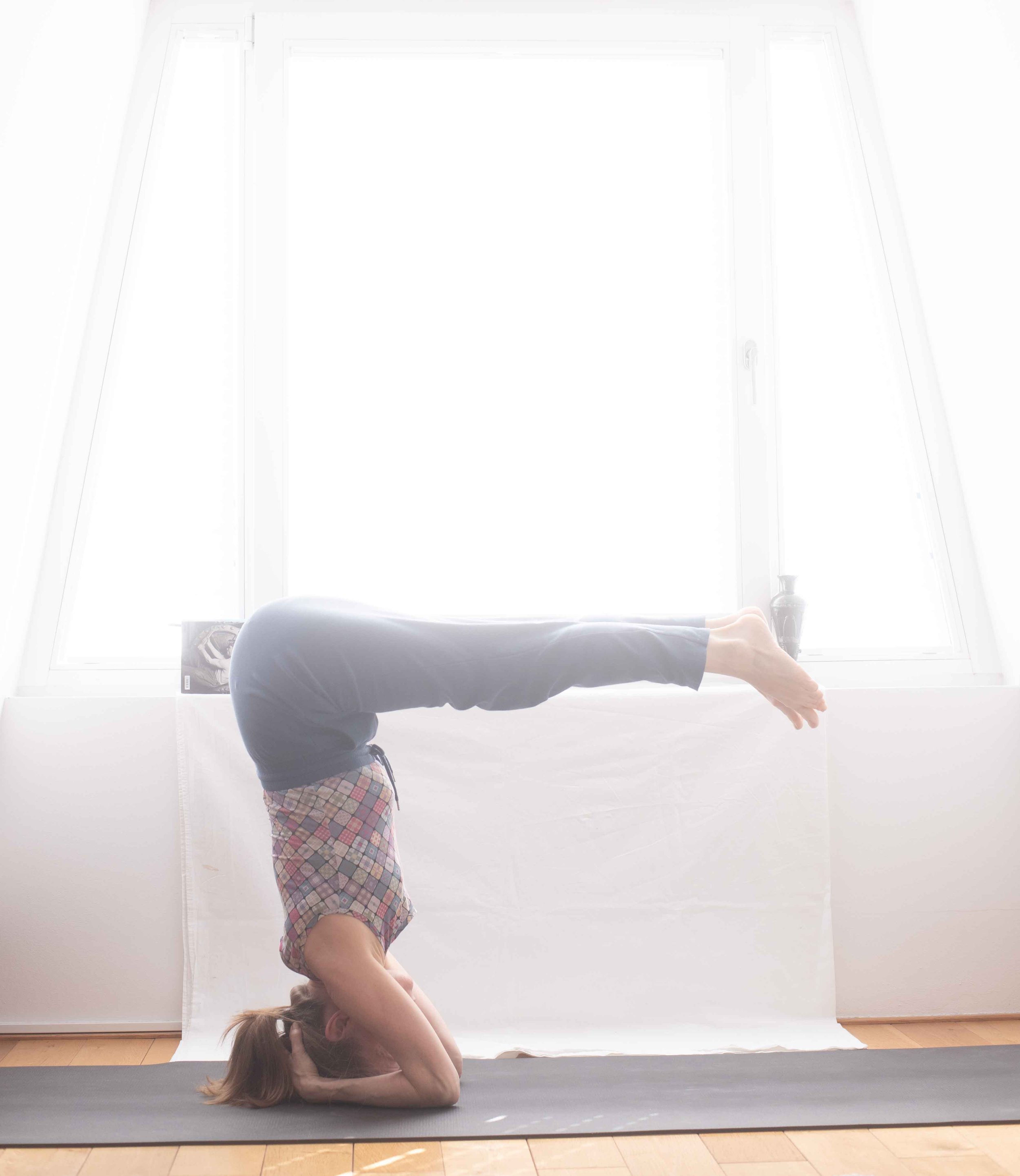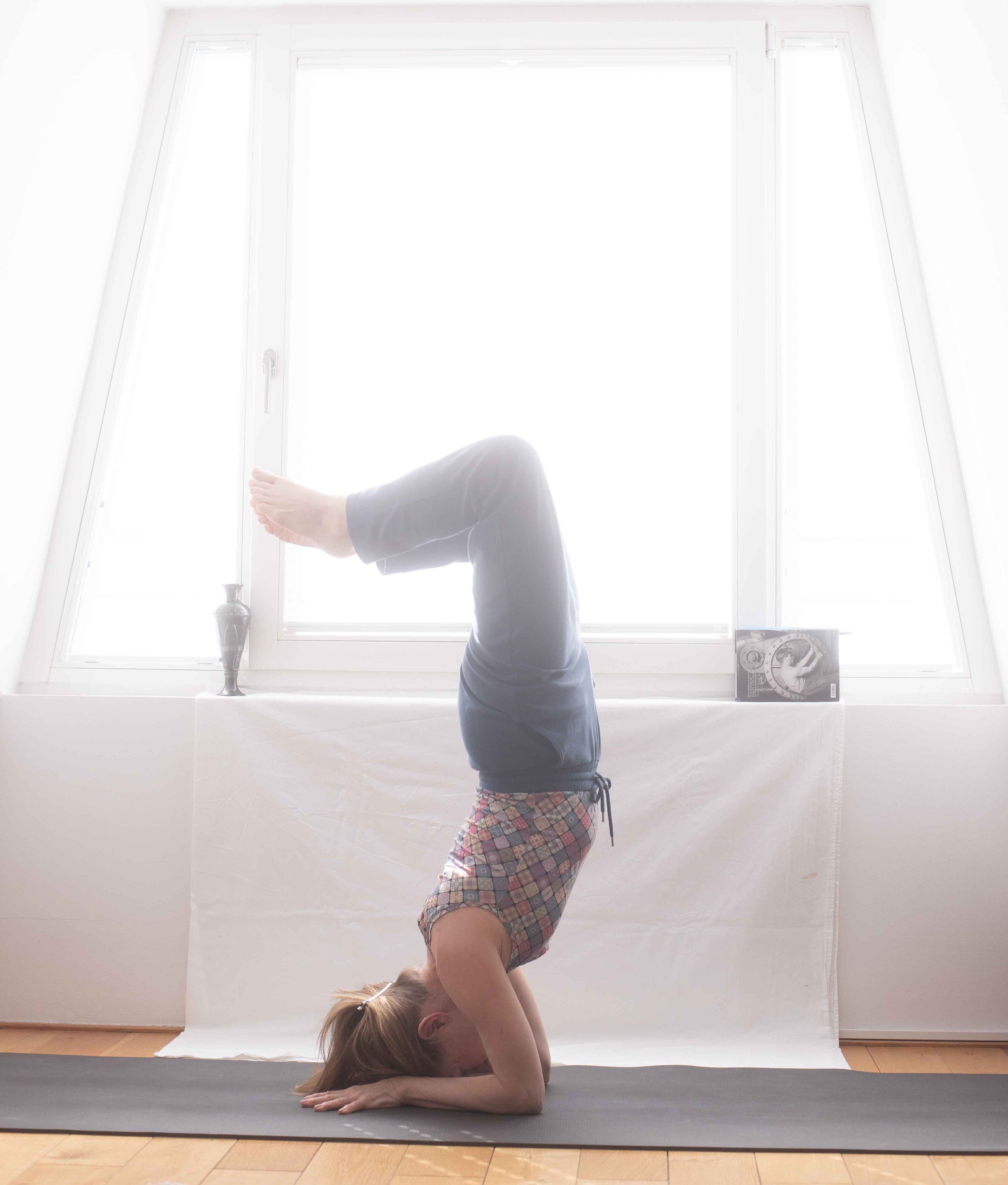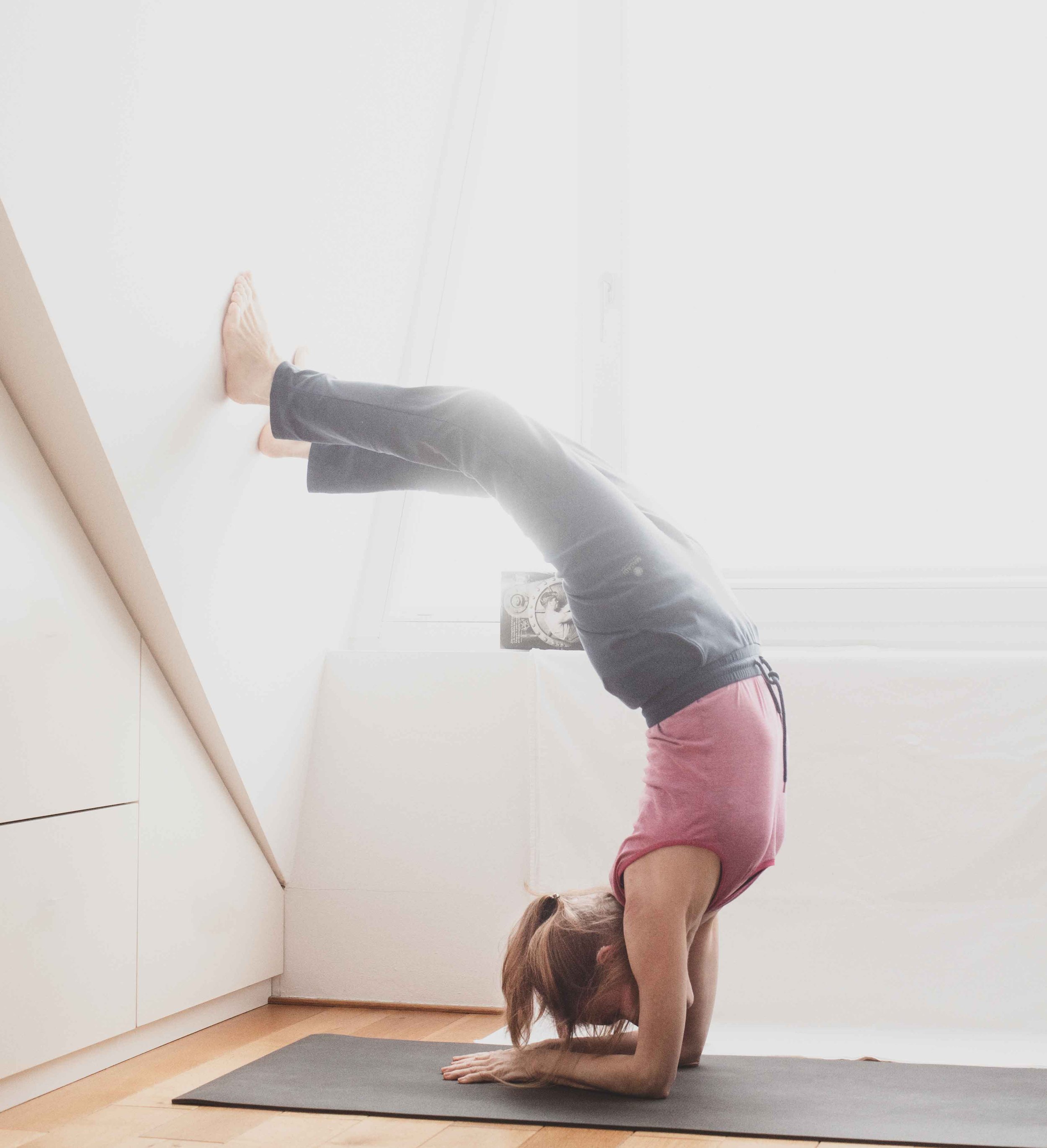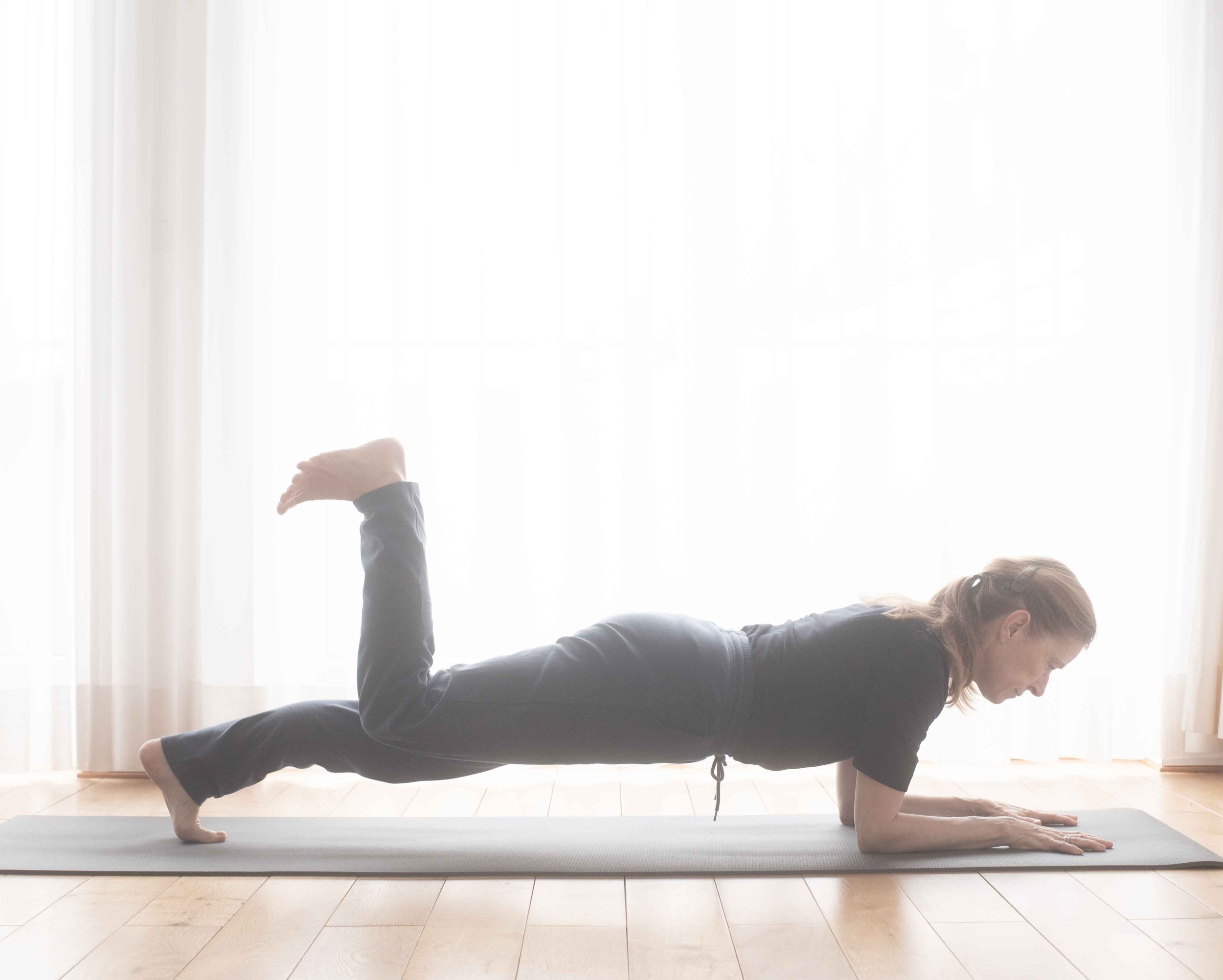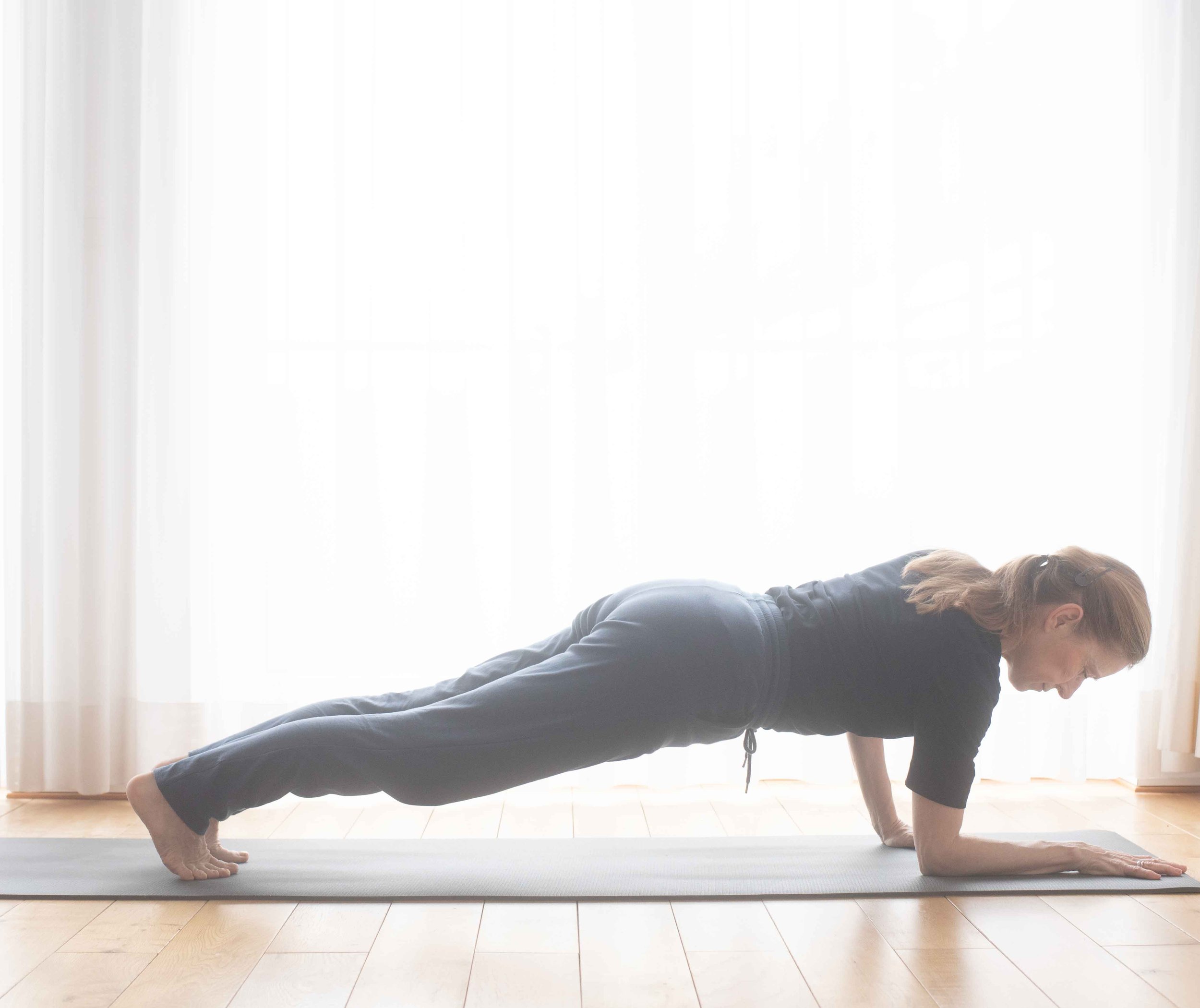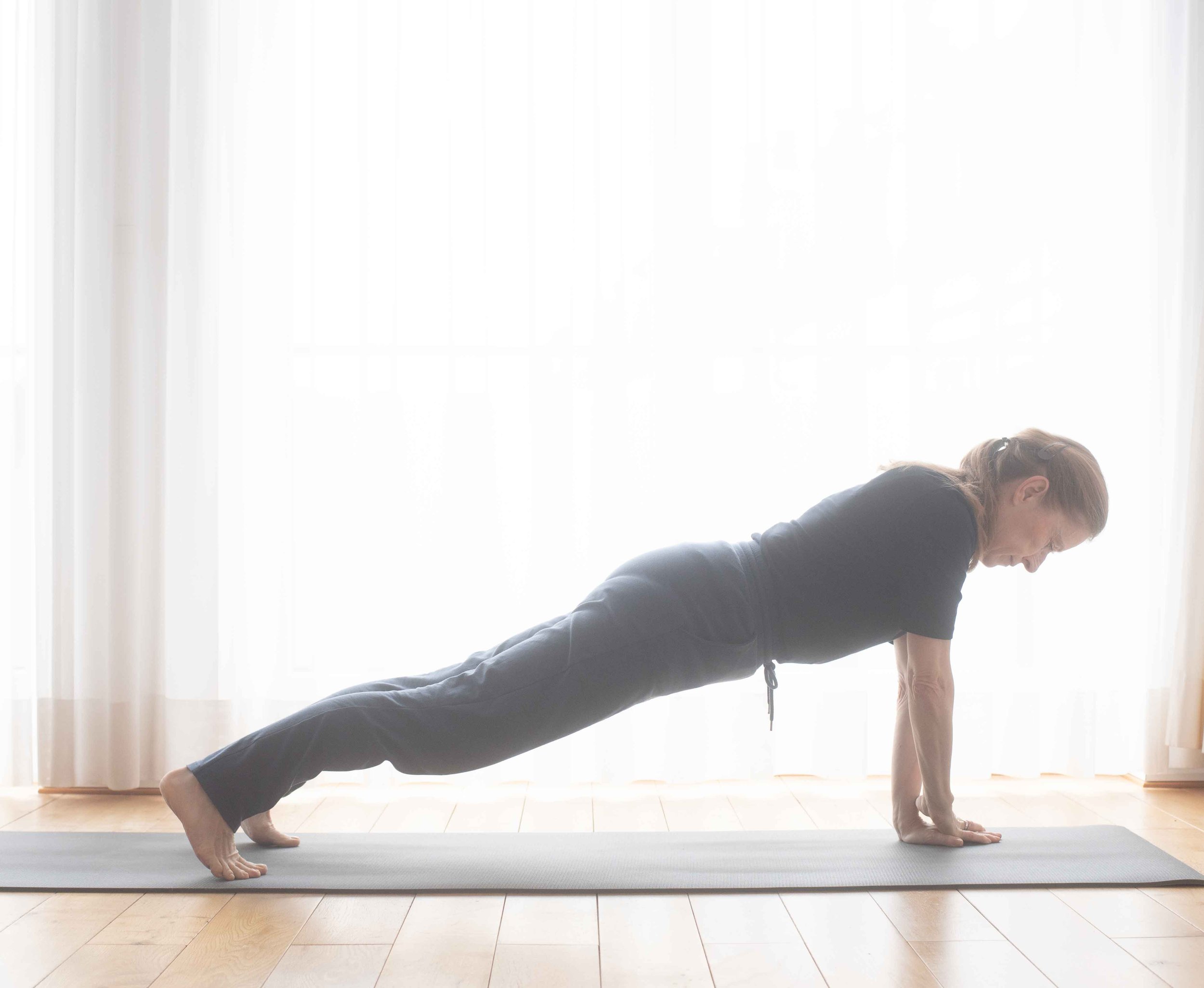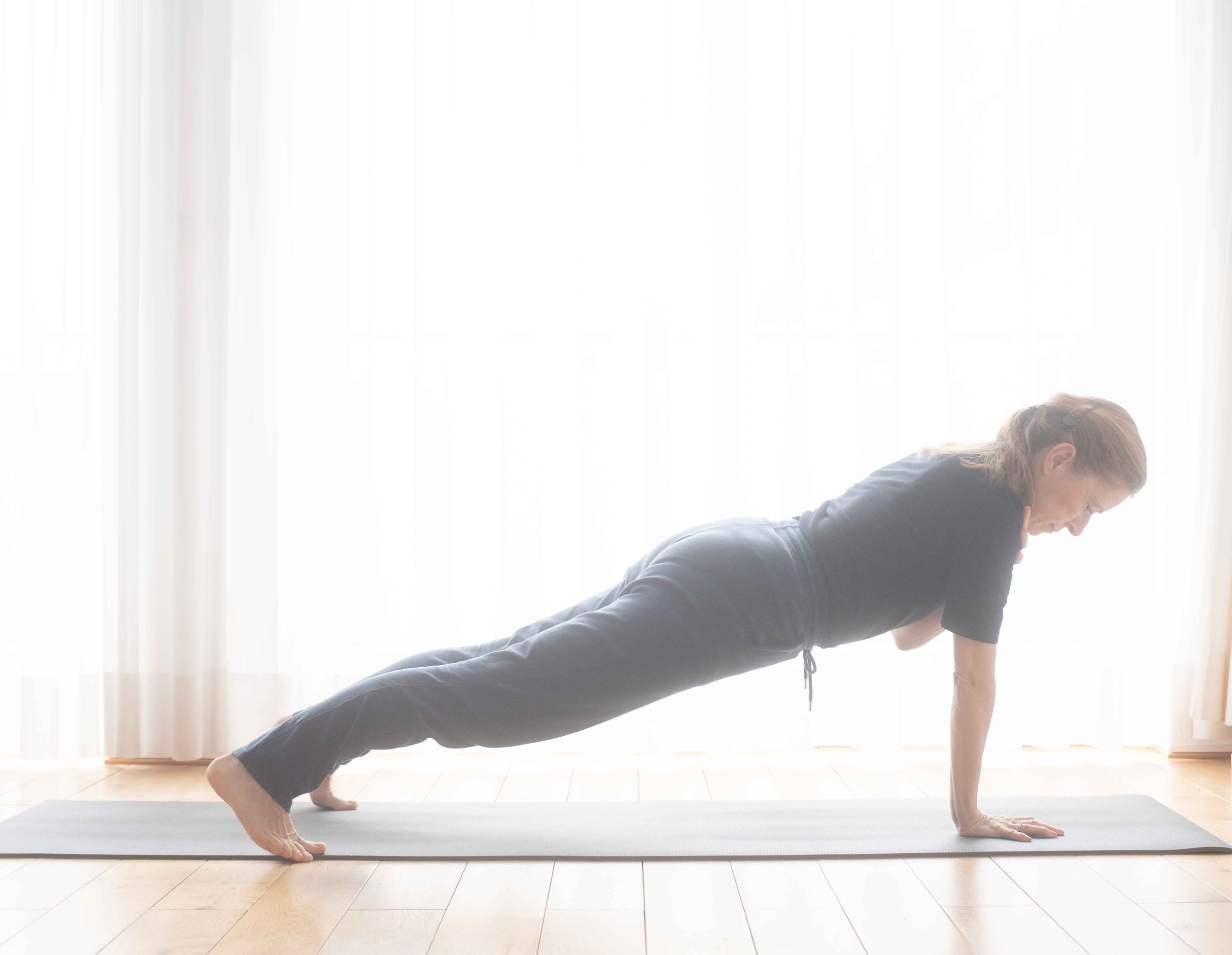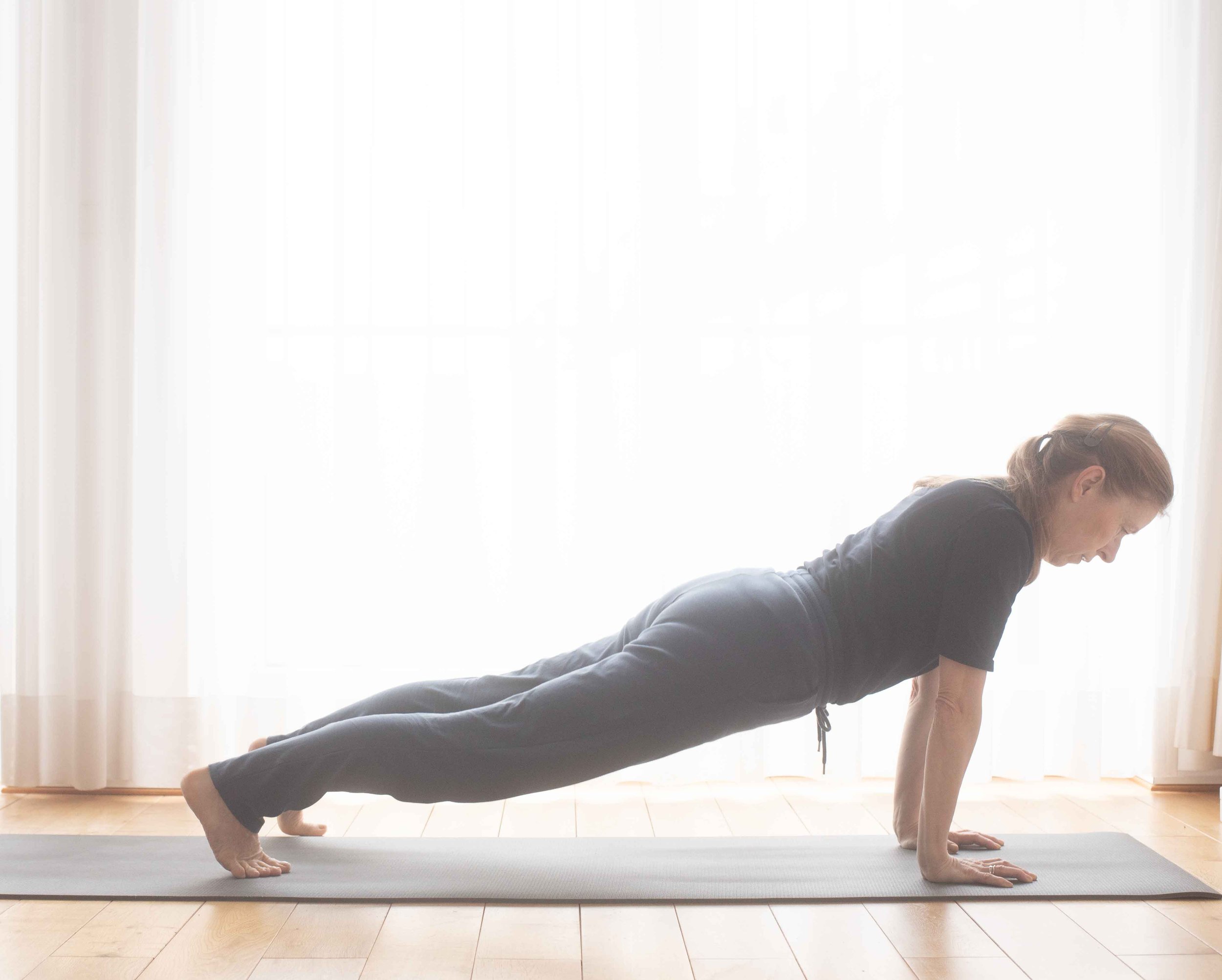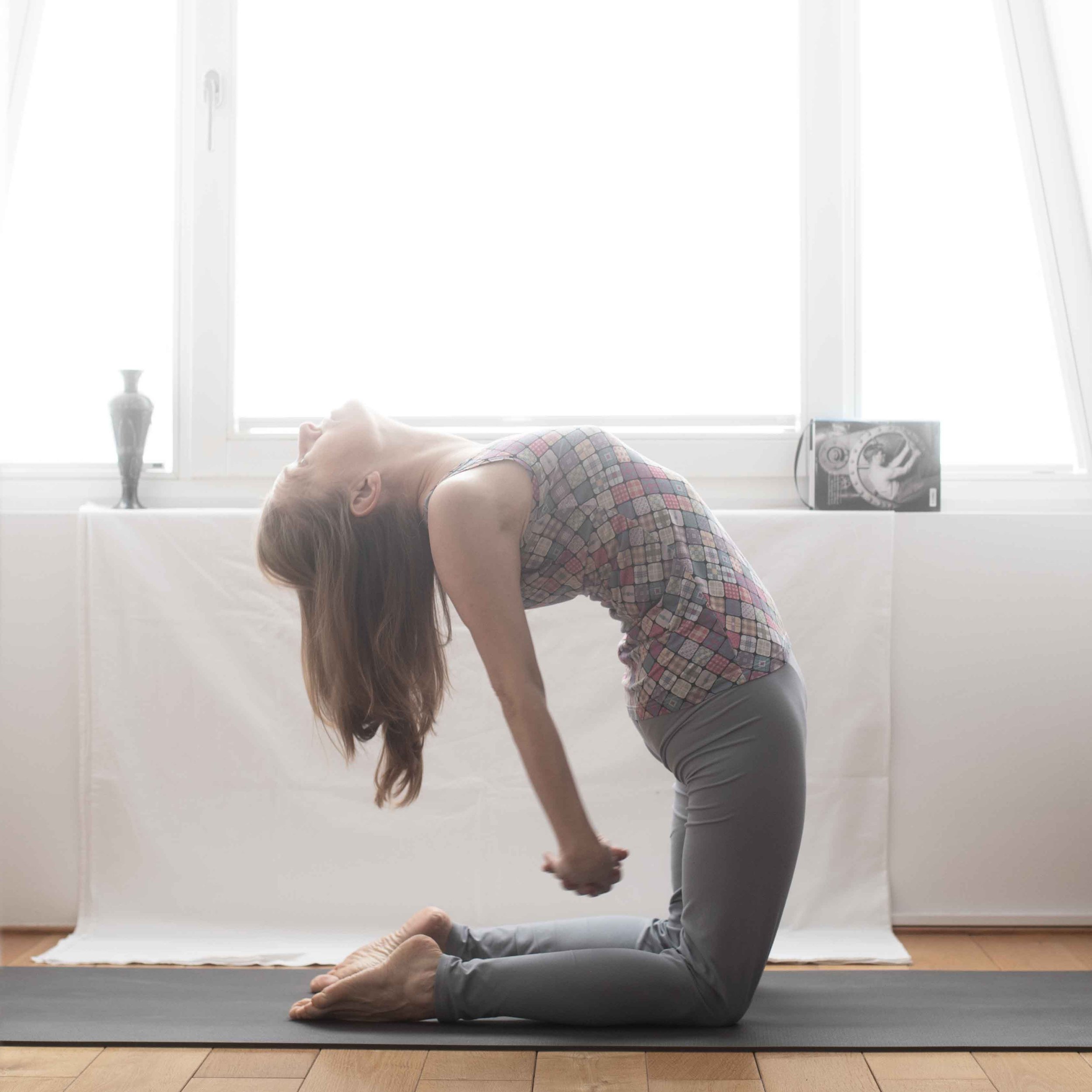November upgrade
Setu bandhasana
It’s getting colder. The body gets stiffer.
The software upgrade drives me crazy. We grow through challenges. The only direction is forward. :)
Finding ease again
Knee to shoulders.
Right now, the priority is to find out what is possible with these limitations and the pain in my left groin. The next step is to work patiently on regaining mobility and, with the help of familiar techniques (breathing, relaxation, muscle engagement), to experience the postures as pleasant again.
I notice small improvements. They help me believe that this injury will eventually pass.
The focus is on forward bends.
There are also very simple forward bends. When standing is the basic position, then sitting is already a mild forward bend, since the thighs are closer to the torso than when standing.
Child’s Pose is a forward bend. Not everyone can perform this seemingly simple posture.
Lying on the back and bringing the thighs toward the torso puts less pressure on the body. It also allows the legs to be drawn up one at a time.
Effort and release are the two poles one moves back and forth between.
Today again I took pictures of my practice. As always, they were edited in #Adobe. Adobe Lightroom has become so much better with AI. The power socket on the wall can now be removed with just one click. That makes taking pictures easier, since it’s no longer necessary to hang up a white sheet. I’m truly impressed.
Tomorrow it continues. The path is set: from simple asanas to more complex ones.
Further
Bending forward.
Moving forward means meeting myself exactly where I am today.
At the moment, that still includes the injury in my groin. Keeping track of my progress will keep me motivated, just as it has in the past.
My journey begins again with forward bends, this time supported by the knowledge and awareness I have gained along the way. Challenging postures are best approached through repetition.
The goal is to once more feel truly at home in an asana. To allow the practice to unfold its full effect, it helps to hold each posture for longer.
I look forward to the rest of the year, and to continuing the journey without standing still.
Being content
Downward facing dog, Germany, September 2024
Well, my injury at the front left hip still does not allow me to do all the asanas I would like to do. Especially the twists are impossible. But I am realizing progress. I will remain patient and see every day what is possible and what is not.
I took my yoga mat with me on a short trip to Lake Garda in Italy. I only managed to practice once. Most hotel rooms are too small and not inviting to do gymnastics on the floor. The one hotel I stayed at had a roof terrace with deckchairs and sunshades. I rolled out my mat next to it. There were children romping around. I smiled at them when they looked over at me. They didn't smile back. Whatever. After a while, I noticed that they were imitating my positions. That's how learning happens. The positions looked perfect. At seven, the body is still soft and flexible, at least for most.
It was a pleasure for me to practice.
Now I'm back home.
I am curious about what September will bring. You can't expect to get better every day. Often you learn in crises, or when you have to overcome difficulties.
Injuries are always a form of feedback. I find weight machines are not so suitable. I can become much stronger by practicing callisthenics. Lifting my own body weight is enough for now.
I wish you relaxed practice.
Focus this week: forward bends
This week I am concentrating on forward bends. This movement is also restricted on the left side due to the injury to the hip flexor. I am trying to find the limits. Then I relax. A relaxed state allows me to go a little deeper into the position. I see slow progress. My left hip now needs much more attention than the right. The right side is an orientation for me.
It all starts with forward bends.
Where am I at the moment?
I first have to determine what is possible and what is not. From there, the journey can continue.
The classic forward bend is paschimottanasana. Or does it all start with the adho mukha svanasana? Or is the basic position of the forward bends hasta padangusthasana? Whatever the case, there are an infinite number of variations. You can approach the forward bends slowly and then increase the intensity.
Every position can be inspiring.
I'm looking forward to the week.
A pracitce update
Forwardbending asana, June 2024
Exactly what I wanted to avoid happened. I injured myself in the gym on one of the strength machines. I also know which machine it was. It was supposed to train the abdominal muscles. To do this, I stretched my feet under a roller. The upper body should be moved forward. A large roller pressed lightly on the back. The task was now to push this roller upwards with the abdominal muscles. The weight may have been around 20 kg. Instead of my abdominal muscles becoming active, my hip flexors became active. At first I thought it was just a simple case of sore muscles, but it turned out to be worse than that. When I ran, I kept almost collapsing. It was mainly the left side that was affected.
Well, I wanted to give my body some rest. The good news is that everything has actually improved. However, I have lost quite a few asanas. Turns to the left are very weak. I will take pictures.
I curse. But I also see that the body is healing.
The first half of 2024 is drawing to a close. A good time to practise more consistently again. There is no alternative.
During the time when I was only practicing irregularly, I was in the functional room at the gym. I'm staying away from the weight machines for now. Callisthenics is a slightly gentler way to train strength, but it's completely sufficient for me. I like the wall bars at the gym. The atmosphere is very motivating.
And on we go.
Signature asanas and Artificial Intelligence
Getting into Sirsasana, March 2024
What could be a signature asana for me after 30 years of practice?
I asked ChatGPT this question today. I liked the answer. For someone (or something) that doesn't know me, the answer is very good. The answer seems to come from someone who knows asanas and knows the classics.
I came up with the question while scrolling on Instagram. A yogi commented under the asana scorpion while in handstand that this used to be his signature asana and that he hadn't practiced it for a long time.
Wow, I thought, a signature asana, that would be it. That's how marketing works.
I liked the idea immediately.
I also liked ChatGPT's response.
My brainstorming: You should be able to perform a signature asana very well. You have to like it and show off your skills.
My preferences for certain asanas have disappeared over time. I love them all, the easy ones, the difficult ones, the boring ones and the crazy ones.
As a result, I don't need any favorite or signature asanas. My asana darlings change. I am happy with them.
ChatGPT cannot replace your own thinking, your own creativity.
The answer by ChatGPT:
Choosing a signature asana after 30 years of practice depends greatly on your personal preferences, body type, strengths, and areas of focus within your practice. However, here are a few iconic asanas that practitioners often gravitate towards after years of dedicated practice:
1. **Sirsasana (Headstand)**: This inversion requires strength, balance, and concentration. It's often considered the king of asanas and can be a culmination of years of practice.
2. **Padmasana (Lotus Pose)**: Known for its association with meditation and spiritual practices, achieving Padmasana requires open hips and a flexible body. It signifies not just physical flexibility but also mental discipline.
3. **Urdhva Dhanurasana (Wheel Pose)**: This backbend is both exhilarating and challenging. It requires strength and flexibility in the back, shoulders, and arms. It's often seen as a symbol of openness and fearlessness.
4. **Natarajasana (Lord of the Dance Pose)**: This balancing pose requires strength, flexibility, and focus. It's a beautiful expression of grace and poise, representing the balance between effort and surrender.
5. **Paschimottanasana (Seated Forward Bend)**: This forward fold is deeply introspective and requires patience and surrender. After years of practice, it can become a signature pose representing inner peace and introspection.
Ultimately, your signature asana should be one that resonates deeply with you, reflects your journey and intentions in yoga, and brings you a sense of fulfillment and accomplishment. It may not necessarily be the most advanced pose, but rather one that holds personal significance and embodies the essence of your practice.
Backbending with props
Back bending, Germany, March 2024
You have to push against the wall with your feet. This could help to open up the upper body.
Pictures are always inspiring.
Dhanurasana - a variation
Germany, March 2024, Dhanurasana - a variation with a strap
I'm always trying out new variations of asanas that I already know. I don't mind being challenged. Reach for the stars. You might just end up on the moon. But if you hadn't reached for the stars, you wouldn't have landed on the moon either.
For me, being overchallenged was always better than being underchallenged, even in my jobs in the past.
In today's position, I naturally ask myself: will the hand ever reach the foot? I'll see. Life is an experiment.
Translated with DeepL.com (free version)
Craw and crane - different yoga poses
On Saturday I went to the asana coaching workshop. We were four women. One of them wanted to learn the crow. The crow is called kakasana in Sanskrit. In Ashtanga yoga, the crow is the pose you practise in the second series.
These two postures are usually mixed up.
Kakasana:
1. the elbows are slightly bent.
2. the shin crosses the upper arm before moving forward into the pose. This is how we were taught in the lesson. This is also an important difference to bakasana.
3. the back is straight.
4. you look forward.
5. try to turn your hands inwards. As a result, the elbows turn outwards.
6. the abdominal muscles are tensed.
Bakasana:
1. the arms are stretched. It is easiest to have the arms stretched from the start.
2. the knees are pressed against the arm near the armpits.
3. the shoulder blades pull apart. The back rounds. This ensures that the weight of the body is not only on the arms. The body is pulled upwards. You try to make the body light.
4 The rounded back makes you look downwards rather than forwards.
5. try to turn your hands outwards to keep your arms straight.
6. the abdominal muscles are tensed.
The woman who wanted to learn the crow was heavily overweight. I estimate that she was 30 kg overweight. Her joints could not support the weight. There are certainly overweight people who have such strong wrists that they can perform this pose without any problems. But that was not the case with the yogini in this class. It would have been better to tell the truth. If the woman had gone into the pose, she might have injured herself. She always stopped before the weight was on her arms. Sometimes it is more important to change your diet than to learn asanas that are not yet suitable.
My joints also hurt after a while. I took advantage of the time to practise the pose again and again and the rest of us also practised parsva bakasana, side crow. We shouldn't get bored while the woman who wanted to learn the pose kept trying to shift her weight forward onto her arms.
As I'm writing this, it occurs to me that the woman probably didn't have the strength to hold herself. I would make the following recommendation:
1. lose weight.
2. then strength training.
3. then practise the crow again.
4. under no circumstances give up.
I have become more aware of this pose since this workshop. Crow or crane is the basic pose for all arm balances.
Each individual must ultimately find and follow their own path to learn the postures they want to learn.
To the pictures:
On the far left I tried kakasana.
In the middle you can see parsva bakasana.
On the right, I tried to stretch my arms to get into bakasana.
Asansa-coaching: From sirsasana to vrschikasana
Germany, Feb 2024, Vrschikasana, first attempts
Yesterday was the Asana Coaching workshop with the Sivanandas. A lot of yogis filled the lobby pretty quickly. It turned out that most of them wanted to do soft yoga. Only four women, including myself, had signed up for the asana coaching. One woman wanted to learn the headstand, one woman wanted to learn the crow and two women, including me, wanted to learn the scorpion from the headstand.
As you can see in the picture: My scorpion already looks different than it did before the workshop. I learned a lot. But I didn't manage to hold the position for even a second. The other yogini, who also wanted to learn this pose, felt the same way. That's not what I expected to learn either. I am more than happy that I dared to try and get into it. In class, the teacher held my ankles so I wouldn't fall out of the pose.
I went home. I was in a good mood and full of optimism. I didn't hurt myself. I now have a sense of my next steps.
The following exercise was suggested for us to do at home:
1. get into a handstand.
2. from there, move your bent legs backwards. Your knees should be wide apart. This helps with balancing. The feet do not have to touch each other.
3. then return to headstand and move your straight legs in the other direction.
4 This swinging movement forwards and backwards strengthens your sense of balance.
The steps to get into Scorpio:
1. get into a headstand.
2. bend your legs over, knees flexed. The feet are side by side.
3. open your hands and place your palms on the floor.
4. the next step is the most difficult: roll your head onto your forehead and push yourself up. This requires strength. It is easier to lift your head off the mat if you push your hands forward. But this is also the moment when you usually fall out of the pose. I can't imagine not falling.
The headstand should never be practiced in front of a wall. Once you start, you will never get away from the wall. I have seen this happen a number of times.
You can do the scorpion posture with the wall as a support.
In spite of this, tomorrow I am going to try to fall out of the posture at least three times. It's very frightening. Only by consciously learning to fall can you overcome it. I think my backbends are good enough that I won't hurt myself if I fall backwards. It's a test of courage, nothing more.
A start has been made.
The instructions for the crow were also interesting. I will write about that tomorrow.
Will I have the courage to fall out of position?
I could film it. Haha........
From headstand to scorpion
From Sirsasana to vrschikasana:
The devil must have been riding me when I signed up for the 2-hour workshop and wished to learn how to go from headstand to scorpion.
I worked on my headstand in February. I can hold it for three minutes. I tend to get bored. Unfortunately, after three minutes I fall out of the pose. After three minutes, I don't have the strength to do slow, controlled movements.
But pushing myself into scorpion requires even more strength. It's madness.
As you can see, the backbend is pretty weak. When I fall out of the pose, I fall from very high up.
I'm going to the session tomorrow with my heart pounding. I definitely don't want to injure myself.
On the other hand, you should always have the confidence to try something. My goodness, some people manage to put their feet on their heads.
There's only one thing I can think of: Keep practising.
Pictures are the most honest feedback I know.
Well, a start has been made.
Let's see what the position looks like next year.
I'm really curious to see how the yogis will teach me to get into the pose without using the wall.
It's going to be an exciting two hours tomorrow. I’ll report back tomorrow.
PS:
There had to be more attempts. The first picture shocked me. The other pictures were better. I got into the headstand a bit further away from the wall. I now had the courage.
I also learned how to push myself up. You push your arms forward. That way you automatically come up.
I'm almost inclined to try a scorpion again.
The pictures prove what I described the other day. You have to trust yourself to do new things. That's the quickest way to learn.
In Ashtanga Yoga it’s an asana of the Advanced B series.
Adding strength exercises to the yoga routine - planks.
Plank exercises can easily be incorporated into the sun salutations. It is a good idea to insert strength exercises before or after chaturanga dandasana.
Ultimately, chaturanga dandasana is a plank position.
The exercises are again taken from Sean Vigue's book '30 days of planks'.
In today's post, I present six more plank variations.
1st exercise:
Support yourself on your elbows. The body remains straight. Then bend your leg. Then change sides.
2nd exercise:
From a classic plank position with outstretched arms, first place the forearm of one arm on the floor, then the other. Then return to the classic position.
3rd exercise:
The hand touches the wrist of one arm. Then switch again.
4th exercise: The right hand touches the shoulder of the left side. Then switch again. This exercise was also recommended to me in the gym and becomes easier if you move your legs further apart. This makes it easier to balance.
5th exercise:
This is a side plank that I really like. It is a preparation for the 3rd Ashtanga Yoga series. The author also recommends changing sides quickly here. Since you are in a classic plank position as a transition, you can also add a push-up.
6th exercise:
One leg is moved to the side and then back again. The change follows immediately.
If you repeat the exercises up to 20 times, you will know what you have done.
These are just suggestions. It's best to pick out three favorite positions. If these get boring, try other variations.
Typical mistakes:
- When I looked at the pictures, I realized that the shoulders were not directly over the wrists. I was able to correct that.
- I also realized that my body wasn't really straight. You have to tighten your abdominal muscles to keep your body straight.
Have fun practicing.
Yoga with the Sivananda community
Feb 2024, Ubbaya padangusthasana
Yesterday morning I woke up feeling dizzy. I crawled straight back into bed. Somehow I still managed to get up in time for lunch. We went out to eat. Sometimes it's good not to have to do anything yourself.
In the evening I managed to go to Sivananda Yoga. I enjoyed being guided through the class there too. It's fun to practise with other yogis.
In the Sivananda classes, pranayama is also practiced, which I like.
Tomorrow is another power day. I will see. You have to accept what is thrown at you and then make the best of it.
Stay present.
Trikonasana variation
Trikonasana variation, Feb 2024
Small changes in an asana also change the stretch. If you pull your arm to the side, you stretch the entire side of your body.
Sometimes I bring the arm behind the back to the thigh. The hand rests on the thigh and supports the body to turn up and pull the shoulder back.
From trikonasana you can easily bend one knee and then practise utthita parsva konasana. This is a different way to get into the pose than in classical Ashtanga where you first bring the legs into position and then the upper body.
If you stretch both arms out to the side, you need to balance better.
If you keep thinking about variations, you will begin to understand the postures better. The mind remains alert. You interrupt the autopilot mode.
You can practise more difficult variations at the beginning of the exercise. This insight is a game changer.
How do I organize my exercise?
Trikonasana, Feb 2024
I read a very interesting book at the weekend. It's called 'The art of practice' and was written by a juggler called Laido Dittmar. Laido Dittmar works for the Cinque du Soleil. I came across him via a Facebook ad. The book is not available on Amazon. This is also not an affiliate link.
The best way to learn is from masters who have had difficulties themselves and have overcome them. Laido was born into a circus family, but only started juggling late in life at the age of 17. By then he was already considered far too old. He also had immense difficulties reaching a very good level.
Laido has interviewed and studied the artists who are considered talents. He wanted to know what they do differently.
He looked into the question of how to train more effectively.
And he came across quite a few things.
For one thing, the talents themselves don't know what they do differently from those who remain mediocre. You can't ask the difference, you have to observe it.
This is one of the differences that makes a huge difference in training and is much more effective than what most people do:
The difficult movements or skills are practiced first by the best. You challenge yourself at the beginning of a workout, not at the end. Every day you look for new challenges and try to get a little bit better.
The normal practitioner spends time on warm-ups and routines before learning new movements, before tackling new challenges in that area.
I just needed to hear that so clearly.
I've known for a long time that it's nonsense to practise Ashtanga for two hours and then practise the most difficult pose at the end, for example kapotasana. For years, I practiced the entire 1st series first, then the 2nd series immediately afterwards, until I reached the pose that I could no longer do. That was kapotasana.You have no strength, no energy, no focus anymore at the end. You end up torturing yourself. I was usually exhausted after two hours of Ashtanga.
I saw something similar in the Mysore classes when the bridge is practiced at the end of the first series. The bodies were exhausted. The yogis were lying on the floor and had to or wanted to push themselves into the pose again. Then they succeeded. Effective practice is different.
I'm going to change the order of the asanas even more radically than I have done so far.
Laido Dittmar wrote that even the warm-up is sufficient, but not excessive, for those who are considered talented.
For me, this would mean: sun salutations and then slowly but surely practicing the difficult asanas. Twenty minutes of backbends before you get weaker. The series can then follow. It doesn't matter whether you leave out one asana or another.
This book will change the way I build up my yoga class again.
It will allow me to practise much more effectively. I will torture myself much less at the end of a strenuous practice. The difficult asanas will already be behind me. The book gives more insights. It’s to the point. I highly recommend it.
Life is an experiment.
Variations of asanas
Ustrasana preparation, Jan 2024
It is particularly important to know preparatory variations for challenging asanas. I want to repeat difficult asanas and hold them for longer. On days when nothing seems to work, I practise simpler variations. But there are also days when you want to push the limits. These are the days for the variations that go a little further.
Since my back injury, I've learned one thing: the exercises have to adapt to me and not the other way around. Every series is an offer. You have to train wisely.
Friday is primary on the schedule
Ardha baddha padmottanasana, Jan 2024
Friday is primary on the schedule.
Forward bending is the most practiced asana in this series.
Practice daily
Leg stretch, January 2024
It goes up and down. Powerful exercises follow lame exercises and vice versa. It's always good to practise. You learn discipline. You learn to deal with frustration. You even get to know yourself. And there are also enough exercises to inspire you.
Even today it was difficult to get through the 90 minutes. I kept thinking about stopping. But that's almost a taboo. When I start practising, I practise for 90 minutes. Starting is the most difficult moment. Once this has been mastered, I move on. Making the beginning as easy as possible is a little trick to get yourself practising.
Every exercise session also has highlights. So I'm happy that I can do chaturanga more easily again during the sun salutations. I no longer have to put my body down on the mat. I have become stronger. That feels good.
Going to the gym makes sense.
Instead of sputa kurmasana, I practise the asana in the picture. My left hip is still overstretched and painful, but I can already feel an improvement.
I'm looking forward to the 1st series tomorrow.
Practicing daily is not just a recommendation for yoga. What gets attention grows. What doesn't get attention withers and slowly dies away.
Bala Kakasana, Kakasana and Bakasana
Let's start with the terminology. There is the baby crow, the crow and the crane. In Sanskrit, the three asanas are called bala kakasana, kakasana and bakasana.
You need strength to perform these three asanas. The muscles of the entire body are trained. The upper body carries the weight of the whole body. The abdomen must be tensed and pulled in. The legs must be kept in the air. All of this requires energy and strength.
I fooled myself once again with bala kakasana. This baby crow is also exhausting. I thought it would be an easy pose.
The nice thing is that you can integrate the postures well, for example after utkatasana. I usually practise bakasana after utkatasana. The special thing about bakasana is that the arms are stretched. I could do this pose before. I'm going to get it back again.
As a method for learning these asanas, I recommend repetitions and staying in the pose for longer.
Using the right technique is also very important. The hands are like claws. The upper body is rounded. The belly is pulled in. Bakasana becomes easier when the knees are close to the armpits. It is also easier to have the arms stretched from the beginning.
Have fun with the crow and the crane.

